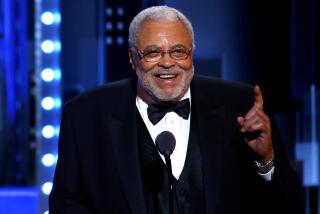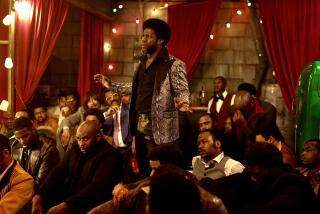A Revamped ‘Tom Jones’ Romps Again : Movies: Director Tony Richardson welcomes the opportunity to fine-tune a film he made 25 years ago.
Earlier this year, with much fanfare, Columbia Pictures reintroduced audiences to 1962’s Academy Award-winning best picture, “Lawrence of Arabia.” Newly restored and reconstructed, David Lean’s masterpiece once again assumed the mantle of British film-making excellence--the apotheosis of taste and literacy.
Now comes the reissue of the following year’s Oscar-winning best picture, Tony Richardson’s “Tom Jones,” which represents an entirely different British tradition. This boisterous and bawdy romp through 18th-Century England is to “Lawrence” what “Monty Python’s Flying Circus” is to “Masterpiece Theatre.”
Newly restored and re-edited by Richardson, “Tom Jones,” which hasn’t been seen theatrically in 15 years, opens today at selected theaters.
In the film, Richardson turns the English countryside into a comic arena that Mack Sennett would have immediately recognized. Dogs and pigs run amok in the stately homes. Great gusts of ribald humor blow through its corridors. Lusty wenches waylay young men on nocturnal strolls.
Visually, the film runs through a whole bag of tricks--jump cuts, freeze frames, speeded-up motion, a roving camera, titles over dialogue scenes and actors addressing the audience directly.
The rollicking charade, starring 27-year-old Albert Finney in the title role, also earned Oscars for Richardson, writer John Osborne and composer John Addison, and nominations for Finney and the late actors Hugh Griffith and Edith Evans as the country squire and his meddlesome sister.
“Tom Jones” took America by storm in 1963. So popular was the film that a New Yorker magazine cartoon depicted a patient moaning to his shrink, “Doctor, what’s my problem? ‘Tom Jones’ depressed me.”
In an interview last week in his wooden, split-level Hollywood Hills home, Richardson, 61, explained that a legal dispute between his company and United Artists had held “Tom Jones” hostage until six months ago. Then, when the lawyers all decamped, Richardson found himself with a deteriorated negative and a sound track that sounded prehistoric.
Fortunately, there was a mint-condition print available and Richardson was able to work from that. The director said he grabbed the rare opportunity to return to the editing room and fine-tune a movie he had made a quarter-century ago. The new version is minus seven minutes of earlier footage, “all trims, the kind I would have done then if I’d been smart enough. It’s taken me 25 years to not be so dumb.”
But he said it was the music that “dated the film more than anything, because state-of-the-art recording is so totally different than it was 25 years ago.”
Working with Addison, Richardson completely redubbed the sound track. The two even added new instruments and sound effects to strengthen and sweeten the sound.
The Samuel Goldwyn Co. is planning to use the theatrical reissue to recycle “Tom Jones” through all the ancillary markets--videocassette, pay TV and over-the-air TV syndication. Meyer Gottlieb, Goldwyn’s president and CEO, said that the film’s status as an Oscar-winner and as a period comedy will help it “overcome the passage of time.”
Before making “Tom Jones,” Richardson teamed with playwright Osborne, best known for his “angry young man” dramas, to produce such socially realistic film portraits of contemporary provincial life as “Look Back in Anger” and “The Entertainer.”
With “Tom Jones,” Richardson recalled, the two men wanted to make a film that was “pure pleasure, a kind of vacation, just to have a good time.”
However, filming it turned out to be anything but.
“We were short of money, the script was being rewritten the whole time and Albert Finney didn’t consider the role sufficient for his acting,” Richardson remembered. “He wanted to play Hamlet. Ironically, it probably will be the role he is most remembered for.
“We were on the edge of danger the whole time. Hugh Griffith was drunk from morning to night. You never knew if he’d be on the set or lying in a ditch. He once tried to kill Edith Evans by stampeding a coach she was in. Another time he took a shotgun and fired at the crew. He blew the top off my Thunderbird!”
Griffith’s Squire carried a whip with which, according to Richardson, the actor delighted in terrorizing the cast. In one night scene, he brought the whip down sharply on Finney’s back, which was covered only in a thin cotton shirt.
“Finney turned and poked him in the face,” Richardson said. “Finney’s back was bleeding, Hugh Griffith’s lips were bleeding and the two walked off the set and said they wouldn’t work with each other again.”
One of Griffith’s drunken accidents winds up in the film. At the finish of a scene, Griffith yanks his horse’s reins so sharply that the animal turns in a circle and falls over. “We thought he killed himself. The horse fell right on top of him.”
“Tom Jones” was met with the scorn of many British critics.
“What they considered innovations--which were only the techniques of the silent movies--were a terrible shock to what was then called well-made film making. But American critics were great.”
The film, made for less than $1 million, earned 30 times that much, said Richardson, who wound up collecting two Oscars, one as producer and one as director.
Richardson credits the trend toward revivals of movie classics to the video revolution and TV.
“TV has given an audience that wants to go out (to movies) a taste for seeing old films in better condition and in cinemas, where they can have a totally different experience than they can from TV,” he said. “At a certain point, (going to revivals) will become part of everyone’s moviegoing.”
And which of his film would he like to revive next?
Richardson chuckled. “Well, I hope some day to revive ‘The Charge of the Light Brigade’ (1968). It did very well in Europe but, curiously enough, not here. American critics took it for a metaphor for Vietnam and it baffled them. But maybe it’s a movie whose time will come.”
The director laughed heartily. “But that film is also locked in a contract dispute with UA!”
More to Read
Only good movies
Get the Indie Focus newsletter, Mark Olsen's weekly guide to the world of cinema.
You may occasionally receive promotional content from the Los Angeles Times.










